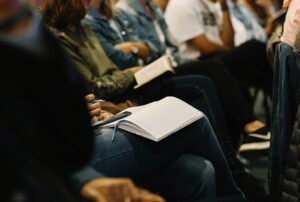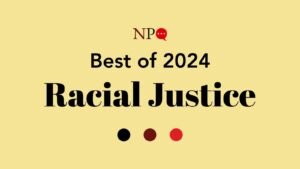
Casting a ballot, while important, is “the floor,” or the bare minimum, when it comes to creating real social change. Electoral engagement is key, without a doubt. But voting is only one part of what it takes to ensure that Black communities are seen and Black people are treated as full human beings who can thrive in this country.
Black youth and their collective power go beyond their strength as a voting bloc, and no one knows that better than Black youth organizers—young leaders who need sustained investment from all levels of government and philanthropy to continue unlocking Black youth power.
Black Youth Fighting Voter Suppression
Black youth are part of the largest voting bloc in America—Generation Z and Millennials. And record numbers of young people voted in 2020, with Black youth voting in battleground states in numbers that propelled Biden and the Democrats to victory. While white youth voted for Biden by a slim margin (with 51 percent voting for Biden compared to 45 percent for his opponent), youth of color gave him overwhelming support, ranging from 73 percent among Latinx youth to 87 percent among Black youth. This massive turnout happened in the middle of a pandemic and after years of unchecked voter suppression. Nearly 10 years ago, the Supreme Court gutted the Voting Rights Act. Ever since, voter suppression and discriminatory voter laws have been designed to block communities of color from the ballot box. Between 2012 and 2018, 1,688 polling places were closed in states that were previously covered by Section 5 of the act, which required preclearance from the federal government for any changes to voting policies and procedures.
Black youth organizers are fighting voter disinformation and suppression targeted at Black voters to ensure access to the ballot box. From the Second City to the Magnolia State, youth organizers are advancing policies to re-enfranchise Americans, an issue that disproportionately affects Black people. Chicago Votes has led some of the most revolutionary voting rights efforts through its Unlock Civics program. In 2019, the organization wrote and passed landmark legislation—the Voting in Jails bill—that expanded voting access for incarcerated citizens who are eligible to vote. This made Cook County Jail the first jail in the country to become an official polling location. Due to the tenacity of Chicago Votes youth organizers, Cook County Jail detainees had a higher voter turnout in the June 2022 primary than the city as a whole. Now, the youth are organizing to pass legislation that would restore voting rights to people in prison. Meanwhile, Mississippi is one of only three states to impose lifelong voting bans on people convicted of certain felonies. Mississippi Votes (MS Votes) worked to fight over 70 voter suppression bills and supported 52 voter suffrage applications through the 2021 Mississippi legislative session. Today, MS Votes continues to lead voting rights restoration efforts.
Investing in Black Youth: Beyond Electoral Engagement
Even as Black youth organizers fight for voting rights, they must be seen and invested in as more than electoral engagement machines. Dakota Hall, Executive Director of the Alliance for Youth Action, described in a piece for the National Committee for Responsive Philanthropy why philanthropy must make bold investments in movement change. As Hall writes,
For local youth-led organizations in the Alliance Network, partisan political funding enables organizations to deepen their impact, be innovative in building power for their communities, and allows youth organizers to have the conversations that need to be had in our communities year-round. These dollars are critical for accountability work, growing a pipeline of strong political champions, and how we win elections and policy change.
The policies that Black youth are fighting for include student debt relief, college affordability, divesting from the police to reinvest in social services, voter re-enfranchisement, decriminalizing marijuana, promoting healthy babies and mothers through affordable healthcare, ending medical discrimination, and realizing racial equity through economic investments in Black communities, which can be achieved through reparations.
Sign up for our free newsletters
Subscribe to NPQ's newsletters to have our top stories delivered directly to your inbox.
By signing up, you agree to our privacy policy and terms of use, and to receive messages from NPQ and our partners.
Look to Black youth organizers for the answers. In the Midwest, for example, Black-led youth organizations that care for communities facing police violence have enacted real change. The Minnesota Youth Collective (MNYC) set up mutual aid in their communities after the killing of George Floyd in 2020. Currently, MNYC is a part of the Minneapolis United for Rent Control coalition, building a movement for strong rent control, mobilizing youth to attend council meetings, and organizing community events to demand policies that reflect the needs of the majority-renter population in a city where the homeownership gap between white people and people of color is the largest in the nation. In November 2021, the Ohio Student Association (OSA) worked with a coalition of organizations, activists, and individuals—led by families who lost loved ones to police violence—to canvass local residents, host educational events, and collect signatures. Together, they passed the Citizens for a Safer Cleveland ballot initiative, which focused on reforming police accountability and oversight processes by asking for increased authority for the Civilian Police Review Board.
Black youth organizers have also been at the forefront of the fight to cancel student debt and make higher education affordable for all. Their pressure led President Biden to eliminate a significant amount of student debt: up to $20,000 for Pell Grant recipients and up to $10,000 for non-Pell Grant recipients whose individual annual incomes are less than $125,000 (or $250,000 for married couples and heads of households). For nearly a decade, OSA has been dedicated to changing the policy landscape for higher education in Ohio. OSA youth organizers are working to get debt navigation programs passed in state legislatures and to end “transcript traps,” where colleges withhold transcripts from students over unpaid bills. The Black women-led Virginia Student Power Network (VSPN) passed legislation to provide in-state tuition and state financial aid for undocumented students in Virginia. VSPN organizers at the University of Virginia also won a tuition freeze at their university, which means that tuition rates are guaranteed to stay the same until the 2024–2025 academic year.
Black Youth Organizing for a Better Future—For Everyone
According to the most recent Alliance for Youth Action poll of people ages 17–39 in 11 battleground states nationwide, 86 percent of this demographic age group plan to vote in the midterms. These young people don’t fit the stereotype once attributed to millennials: spoiled brats eating avocado toast. They are fighting for better futures for us all, and they are ready to make their voices heard.
Given the high percentage of youth who already plan to vote, the conversation about Black youth voters needs to change. Instead of asking if Black youth will show up at the polls, we must ask: Who will they vote for when they show up? Have midterm election candidates shown up for Black youth and the issues they care about most?
Gen Z-ers and Millennials live in an era of constant crisis. Amid a nationwide rise in school shootings and gun violence, Black and Brown youth must also deal with neighborhood vigilantes and police killing their peers like Trayvon Martin and Breonna Taylor. They are trying to survive a global pandemic and the everyday effects of environmental racism—like unsafe water in predominantly Black cities—while preparing for their futures under a global climate emergency. After seeing their parents suffer through multiple economic recessions, they find themselves earning wages that are not adjusted for inflation. And they have seen how a resurgence of white supremacism and the rise of authoritarianism that led to an attempted coup on January 6th.
It is almost a broken record now: every election year, we are told, is the “most important election of our lifetimes,” but the issues that impact Black youth seem to only receive attention when it is time for them to vote again. The singular focus on getting out the Black youth vote during an election year—followed by years of ignoring the issues and policies that would help Black youth thrive—reminds me, an elder Millennial, of a Wyclef Jean song. “Gone Till November” tells the story of a man who leaves his girlfriend for long periods of time to take care of “other business,” neglecting their relationship. Elected officials take a similar approach to Black communities, putting on the backburner the policy priorities of Black voters—and Black youth specifically—until it is time to seek their votes again. Young people see through this facade. While Black youth will vote this November, youth-led civic organizations should not be seen as get-out-the-vote machines.
For Black youth organizers, democracy is about more than voter participation. Voting must be combined with other actions to protect our democracy. This means voting and taking direct action, voting and organizing, voting and engaging in civic education. Democracy is about the work that takes place in the street, at city and school council meetings, and at local political homes like Chicago Votes, Mississippi Votes, Minnesota Youth Collective, Ohio Student Association, and Virginia Student Power Network—and it even looks like running for office themselves. Black youth organizers are building power beyond the voting booth right now. It is time for us to invest in Black youth organizing beyond election years.









